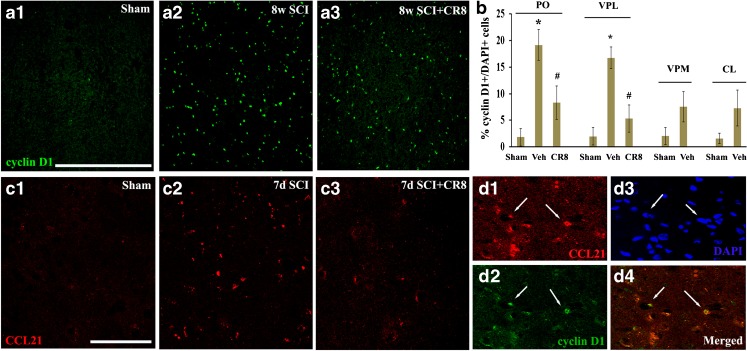Fig. 8.
Expression of cyclin D1 and cysteine–cysteine chemokine ligand 21 (CCL21) was up-regulated in the posterior nucleus (PO) after spinal cord injury (SCI) and reduced by CR8 treatment. (a) Cyclin D1 immunostaining revealed weak signal in the PO from sham rats (a1). At 8 weeks post-injury, numerous cyclin D1-positive cells were observed in the PO (a2) and reduced in CR8-treated animals (a3). (b) Quantification of percentage of cyclin D1+ cells showed a significant increase in both PO and ventroposteriolateral nucleus (VPL) at 8 weeks (8w) post-injury. Treatment with CR8 revealed a remarkable reduction of cyclin D1 expression in these subregions of the thalamus. We did not observe a significant increase in cyclin D1+ cells in the adjacent centrolaterial (CL) or ventral posteromedial (VPM) nucleus. *p < 0.05 vs sham control; #p < 0.05 vs vehicle (Veh) groups. n = 3 sections/location/time point/rat for 6–8 rats/group. (c) Immunoreactivity of CCL21 was weakly detected in the PO from intact animals (c1). At 7 days (7d) after SCI, CCL21 immunolabeling showed a clear increase in the PO, likely within neuronal cell bodies and parenchyma (c2). Importantly, we observed a reduction of CCL21 signal at 7 days post-injury in CR8-treated animals (c3). (d) A subset of cyclin D1+ cells (arrows, green) were co-labeled with CCL21 (arrows, red). Scale bars = 500 μm for (a) and 100 μm for (c) and (d). DAPI = 4',6-diamidino-2-phenylindole

